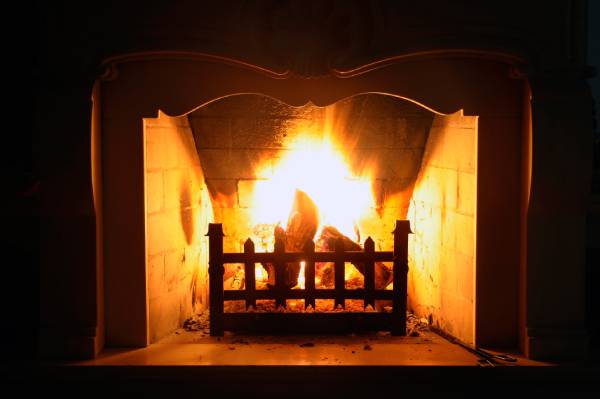
The first snow has fallen for the season here in Michigan, and that means fireplaces are being prepped for another cold season. A fire in your fireplace doesn’t happen spontaneously (which is probably a good thing!) so that means you need to know the right techniques for building a fireplace fire.
Read on to learn the basics for lighting a fireplace fire and making sure you stay toasty warm next to a comfortable flame when the temperatures become unbearably frigid.
What You Need to Start a Fireplace Fire
You have a fireplace or woodstove, now you need a fire! You'll need three things to build a fire:
- Tinder
- Kindling
- Firewood
Choosing Your Tinder
Tinder and kindling are used to start a fire. Tinder must be easy to ignite and burn. Newspaper makes great tinder. Commercial fire starters are an option, as well. If you use a fire starter, you will not need tinder. Note: Never use charcoal lighter fluid or flammable liquids to start your fire. This is extremely dangerous.
Getting the Kindling
The kindling is ignited by the tinder and will assist in igniting your firewood. Good kindling should be dry and small, such as sticks and branches no more than an inch in diameter. If you use a commercial fire starter, you will not need as much kindling.
Building Your Fireplace Fire
"The key to building a fire is to think small." -- The Homeowner's Guide to Chimneys, Fireplaces, and Woodstoves, by Jim Brewer and Ashley Eldridge
A small fire is essential for fireplace safety. A large, roaring fire can be dangerous, and increases the chance of a house fire. So remember, think small when it comes to fires!
Traditional Fire Building
First, arrange two small-to-medium pieces of firewood on the fireplace grate. Place them six inches apart. Distribute tinder between the logs and cover the tinder with kindling. Use a decent amount of kindling, so your fire catches and holds.
Next, place more firewood (one or two pieces) over the other logs, at right angles. Remember: you need good air circulation between and around the logs, so leave enough space between each piece of firewood to achieve this. Finally, light the tinder carefully, and enjoy your fire!
Top Down Burn
This method requires building a stack with firewood, twigs, and branches, and allowing it to burn from the "top down." First, lay three large logs in your fireplace, six inches apart (closer if your firebox is smaller). These logs should run from the front of the fireplace to the back, not side-to-side. Now place three more, slightly smaller, pieces of wood on top of the first pieces.
These pieces of wood should lie side-to-side, opposite of the first three pieces. Continue to build a stack of firewood in this manner: back-to-front followed by side-to-side. Stop building once the stack reaches 2/3 of the way up your firebox. Make sure the bottom layers are wood, and the top layers are small branches and twigs. Add wood shavings or kindling to the top of your pile. The idea is to light the top of the stack, and the fire will burn down to the wood on the bottom.
Before You Build a Fireplace Fire
These steps are important to follow, before lighting a fire:
Start by opening the fireplace damper. This critical steps ensures the byproducts of combustion have an escape route out of your chimney. If this is the first time you’ve used your fireplace this season, it’s likely that the damper is closed. Always check to make sure it’s open before you start a fire!
Next, you’ll want to establish a good draft in your fireplace. This can be easily accomplished by taking a rolled-up newspaper and lighting the tip, then holding the tip as high up in your fireplace as possible. This helps prime the flow of air to fight against issues like backpuffing or poor drafts that may otherwise prevent you from building a fireplace fire with the right intensity.
Once this is done, you can use the ignited newspaper to ignite the kindling in your fireplace! You should have the foundations of a great fire going, all that’s left is to tend it to keep it burning.
Ready to Douse Your Fireplace Fire?
Don't leave the logs to smolder in your fireplace, as this causes creosote to buildup inside the flue and can potentially allow a secondary fire to start, which is a significant safety hazard. Instead, move the logs to the back or side of the fireplace and close the doors tightly.
Don't close the damper until the fire and coals are out. Make sure you’re able to stay with the fire until it’s completely over. Never leave even a slightly burning fire left alone, especially to go to bed. Fires in your fireplace should always be monitored to prevent house fires and other risks.
Schedule an Inspection of Your Chimney Today!
Our CSIA Certified Chimney Sweeps will inspect your fireplace and chimney to make sure your chimney liner is in excellent condition, or to schedule an appointment to install a new liner if necessary! Contact us today! We’ll get you set up right away so you can have peace of mind.
Call Us: 1-800-438-3583
Email Us: office@drflue.com
Office Hours: Mon-Fri: 8am-4pm
Connect with Doctor Flue on Social Media
